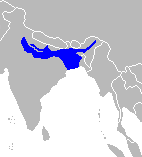Gangeshark
| Gangeshark | ||||||||||||
|---|---|---|---|---|---|---|---|---|---|---|---|---|

Carcharias gangeticus (= Glyphis gangeticus) |
||||||||||||
| Systematics | ||||||||||||
|
||||||||||||
| Scientific name | ||||||||||||
| Glyphis gangeticus | ||||||||||||
| ( Müller & Henle , 1839) |
The Gangeshai ( Glyphis gangeticus ) is a type of river shark (genus Glyphis ) within the Requiem shark (Carcharhinidae). This shark species lives as a freshwater species mainly in the Indian rivers Ganges and Hugli as well as in other larger rivers in India , especially in West Bengal . The shark is classified as critically endangered.
Appearance and characteristics
The Gangeshark is a relatively large shark with a maximum body length of approximately 200 cm. He has a gray back color without noticeable markings and a light belly.
The shark has a rounded snout and large, round eyes with nodding skins . It has an anal fin and two dorsal fins . The first dorsal fin is comparatively large, it lies above or slightly behind the center of the pectoral fin base. There is no interdorsal ridge . The second dorsal fin is comparatively small and is opposite the anal fin. The pectoral fins are relatively large. Like all species of the genus, the animals have five gill slits and no injection hole .
Way of life
The gangeshark is a freshwater species that mainly lives in larger river areas, but also penetrates into the brackish water zones of the river delta. It feeds predatory on various bony fish .
Reproduction
Like other species of the genus, it is viviparous and forms a yolk sac placenta ( placental viviparous ). The young sharks have a size of about 55 to 60 centimeters. The animals reach sexual maturity at a length of about 180 cm.
distribution
The Gangeshai lives as a freshwater species mainly in the Indian rivers Ganges and Hugli as well as in other larger rivers in India , especially in West Bengal .
Danger
The Gangeshark is classified as critically endangered in the IUCN Red List . Most of the known specimens come from museums and were caught in the 19th century. Sightings and shark accidents in the last few decades are likely mainly due to bull sharks ( Carcharhinus leucas ) swimming in the river systems . The rivers where the Gangeshai live are heavily fished. Furthermore, the pollution of rivers, such as the Ganges, endangers the species.
supporting documents
Evidence cited
- ^ Compagno, LJV (2005): Ganges shark Glyphis gangeticus . In: Fowler, SL, Cavanagh, RD, Camhi, M., Burgess, GH, Cailliet, GM, Fordham, SV, Simpfendorfer, CA and Musick, JA (eds). Sharks, rays and chimaeras: the status of the Chondrichthyan fishes. Gland, Switzerland, and Cambridge, UK .: IUCN Species Survival Commission Shark Specialist Group, IUCN. pp. 305-306
- ↑ Compagno, LJV (2002): Freshwater and estuarine elasmobranch surveys in the Indo-Pacific region: threats, distribution and speciation . In: SL Fowler, TM Reed and FA Dipper (eds) Elasmobranch Biodiversity, Conservation and Management; Proceedings of the International Seminar and Workshop, Sabah, Malaysia, July 1997. Gland, Switzerland and Cambridge, UK: IUCN SSC Shark Specialist Group.
- ↑ Glyphis gangeticus in the endangered Red List species the IUCN 2008. Posted by: Hunting Association Compagno, 2007. Retrieved on December 30 of 2008.
literature
- Leonard Compagno , Marc Dando, Sarah Fowler: Sharks of the World . Princeton University Press, Princeton and Oxford 2005, ISBN 978-0-691-12072-0 , pp. 309-310.
Web links
- Species portrait on hai.ch
- Gangeshai on Fishbase.org (English)
